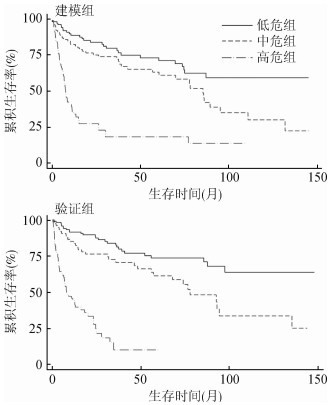| [1] |
Warnakulasuriya S.
Global epidemiology of oral and oropharyngeal cancer[J]. Oral Oncol, 2009, 45(4/5): 309–316.
DOI:10.1016/j.oraloncology.2008.06.002 |
|
| [2] |
Patmanathan SN, Johnson SP, Lai SL, et al.
Aberrant expression of the S1P regulating enzymes, SPHK1 and SGPL1, contributes to a migratory phenotype in OSCC mediated through S1PR2[J]. Sci Rep, 2016, 6: 25650.
DOI:10.1038/srep25650 |
|
| [3] |
Bu JQ, Bu X, Liu B, et al.
Increased expression of tissue/salivary transgelin mRNA predicts poor prognosis in patients with Oral Squamous Cell Carcinoma (OSCC)[J]. Med Sci Monit, 2015, 21: 2275–2281.
DOI:10.12659/MSM.893925 |
|
| [4] |
Sato J, Goto J, Harahashi A, et al.
Oral health care reduces the risk of postoperative surgical site infection in inpatients with oral squamous cell carcinoma[J]. Support Care Cancer, 2011, 19(3): 409–416.
DOI:10.1007/s00520-010-0853-6 |
|
| [5] |
Grimm M.
Prognostic value of clinicopathological parameters and outcome in 484 patients with oral squamous cell carcinoma:microvascular invasion (V+) is an independent prognostic factor for OSCC[J]. Clin Transl Oncol, 2012, 14(11): 870–880.
DOI:10.1007/s12094-012-0867-2 |
|
| [6] |
Zhang M, Rose B, Lee CS, et al.
In vitro 3-dimensional tumor model for radiosensitivity of HPV positive OSCC cell lines[J]. Cancer Biol Ther, 2015, 16(8): 1231–1240.
DOI:10.1080/15384047.2015.1056410 |
|
| [7] |
Zhou Z, Sehn LH, Rademaker AW, et al.
An enhanced International Prognostic Index (NCCN-IPI) for patients with diffuse large B-cell lymphoma treated in the rituximab era[J]. Blood, 2014, 123(6): 837–842.
DOI:10.1182/blood-2013-09-524108 |
|
| [8] |
Sposito C, Di Sandro S, Brunero F, et al.
Development of a prognostic scoring system for resectable hepatocellular carcinoma[J]. World J Gastroenterol, 2016, 22(36): 8194–8202.
DOI:10.3748/wjg.v22.i36.8194 |
|
| [9] |
World Health Organization.Guidelines for controlling and monitoring the tobacco epidemic[M]. Geneva: World Health Organization, 1998.
|
|
| [10] |
Yan LJ, Chen F, He BC, et al.
A novel environmental exposure index and its interaction with familial susceptibility on oral cancer in non-smokers and non-drinkers:a case-control study[J]. Eur Arch Otorhinolaryngol, 2017, 274(4): 1945–1950.
DOI:10.1007/s00405-016-4427-1 |
|
| [11] |
张林峰, 赵连成, 周北凡, 等. 男性饮酒与缺血性脑卒中发病关系的研究[J]. 中华流行病学杂志, 2004, 25(11): 954–957.
Zhang LF, Zhao LC, Zhou BF, et al.
Alcohol consumption and incidence of ischemic stroke in male Chinese[J]. Chin J Epidemiol, 2004, 25(11): 954–957.
DOI:10.3760/j.issn:0254-6450.2004.11.009 |
|
| [12] |
World Health Organization.International guide for monitoring alcohol consumption and related harm[M]. Geneva: World Health Organization, 2000.
|
|
| [13] |
Greene FL, Page DL, Fleming ID, et al.AJCC cancer staging handbook[M]. 6th ed. New York: Springer-Verlag, 2002: 47–60.
|
|
| [14] |
Llena-Puy C.
The rôle of saliva in maintaining oral health and as an aid to diagnosis[J]. Med Oral Patol Oral Cir Bucal, 2006, 11(5): E449–E455.
|
|
| [15] |
Greene JG, Vermillion JR.
The simplified oral hygiene index[J]. J Am Dent Assoc, 1964, 68(1): 7–13.
DOI:10.14219/jada.archive.1964.0034 |
|
| [16] |
Greene JC.
Oral hygiene and periodontal disease[J]. Am J Public Health Nations Health, 1963, 53(6): 913–922.
DOI:10.2105/AJPH.53.6.913 |
|
| [17] |
Bower M, Gazzard B, Mandalia S, et al.
A prognostic index for systemic AIDS-related non-Hodgkin lymphoma treated in the era of highly active antiretroviral therapy[J]. Ann Intern Med, 2005, 143(4): 265–273.
DOI:10.7326/0003-4819-143-4-200508160-00007 |
|
| [18] |
Lee CC, Ho HC, Su YC, et al.
The prognostic ability of log odds of positive lymph nodes in oral cavity squamous cell carcinoma[J]. Medicine, 2015, 94(27): e1069.
DOI:10.1097/MD.0000000000001069 |
|
| [19] |
黄江峰, 王靖雯, 何保昌, 等. 口腔鳞状细胞癌患者生存影响因素研究[J]. 中华预防医学杂志, 2016, 50(10): 880–886.
Huang JF, Wang JW, He BC, et al.
Study of survival factors of oral squamous cell carcinoma[J]. Chin J Prev Med, 2016, 50(10): 880–886.
DOI:10.3760/cma.j.issn.0253-9624.2016.10.009 |
|
| [20] |
Gao CH, Wang ZJ, Li C, et al.
A functional polymorphism (rs10817938) in the XPA promoter region is associated with poor prognosis of oral squamous cell carcinoma in a Chinese Han population[J]. PLoS One, 2016, 11(9): e0160801.
DOI:10.1371/journal.pone.0160801 |
|
| [21] |
Goldstein M, Kastan MB.
The DNA damage response:implications for tumor responses to radiation and chemotherapy[J]. Annu Rev Med, 2015, 66: 129–143.
DOI:10.1146/annurev-med-081313-121208 |
|
| [22] |
Vázquez-Mahía I, Seoane J, Varela-Centelles P, et al.
Predictors for tumor recurrence after primary definitive surgery for oral cancer[J]. J Oral Maxillofac Surg, 2012, 70(7): 1724–1732.
DOI:10.1016/j.joms.2011.06.228 |
|
| [23] |
Zhang YY, Wang DC, Su JZ, et al.
Clinicopathological characteristics and outcomes of squamous cell carcinoma of the tongue in different age groups[J]. Head Neck, 2017, 39(11): 2276–2282.
DOI:10.1002/hed.24898 |
|
| [24] |
Cadoni G, Giraldi L, Petrelli L, et al.
Prognostic factors in head and neck cancer:a 10-year retrospective analysis in a single-institution in Italy[J]. Acta Otorhinolaryngol Ital, 2017, 37(6): 458–466.
DOI:10.14639/0392-100X-1246 |
|
| [25] |
刘善廷, 吴俊福, 郑荣寿, 等. 2009年中国口腔癌和咽喉癌发病与死亡情况分析[J]. 中华预防医学杂志, 2013, 47(7): 586–591.
Liu ST, Wu JF, Zheng RS, et al.
Incidence and mortality of oralcavity and pharyngeal cancer in China, 2009[J]. Chin J Prev Med, 2013, 47(7): 586–591.
DOI:10.3760/cma.j.issn.0253-9624.2013.07.003 |
|
| [26] |
Zhang W, Gao CH, Zhang SH, et al.
Serum annexin A2 level is associated with diagnosis and prognosis in patients with oral squamous cell carcinoma[J]. J Oral Maxillofac Surg, 2017, 75(5): 1081–1087.
DOI:10.1016/j.joms.2016.10.032 |
|
| [27] |
Chen F, Cao YJ, Huang JF, et al.
A novel prognostic index for oral squamous cell carcinoma patients with surgically treated[J]. Oncotarget, 2017, 8(33): 55525–55533.
DOI:10.18632/oncotarget.14821 |
|
 2018, Vol. 39
2018, Vol. 39








